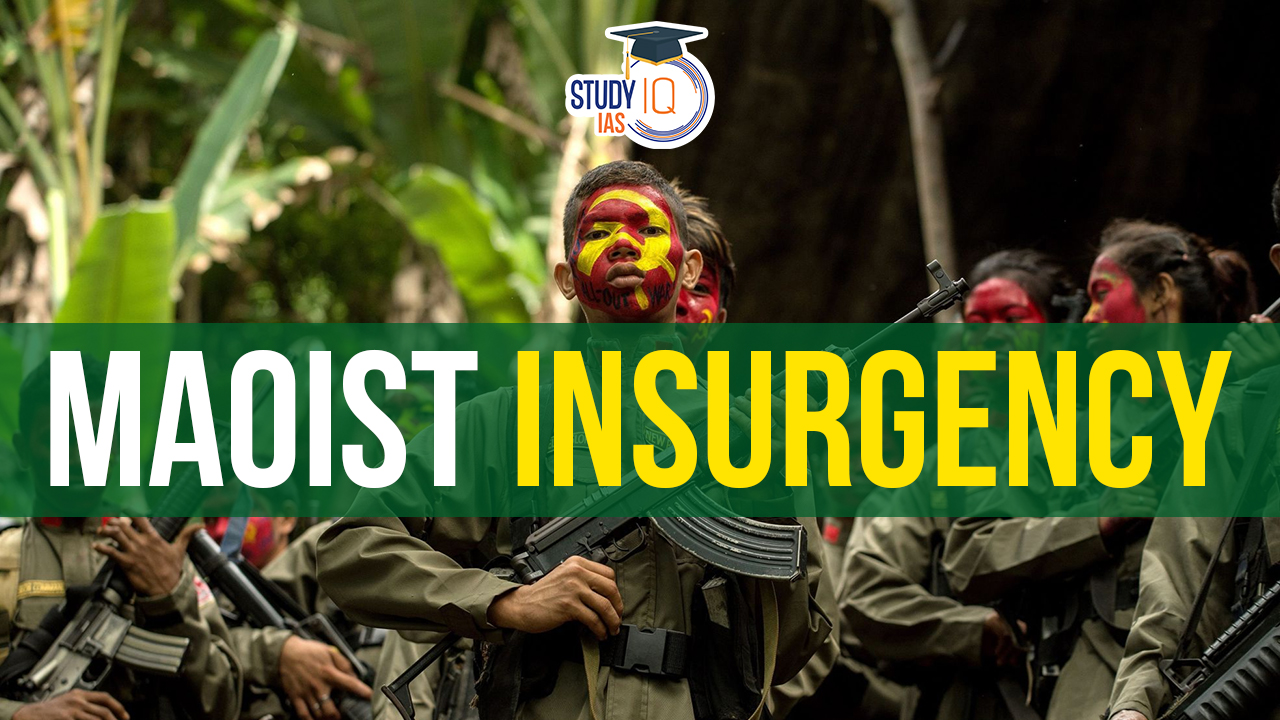Table of Contents
Context: Recently, the insurgents suffered a series of blows with the killing of at least 29 Maoists in the Bastar region in Chhattisgarh.
Background
- The Maoist insurgency in central India, primarily led by the Communist Party of India (Maoist), has been a long-standing challenge for the Indian state.
- Despite experiencing peaks in the early to mid-2000s, recent years have seen a decline in the Maoists’ political-ideological influence.
- However, their ability to target security forces remains a significant concern, prompting unconventional military tactics from the government.
Current Scenario
- Recent paramilitary and police operations, such as the Bastar region encounter, have dealt significant blows to the Maoist insurgents, resulting in casualties.
- The Maoists’ stronghold remains in the jungles of central India, particularly areas with sparse tribal presence and limited developmental infrastructure.
- While their political influence has waned, they continue to pose a threat through targeted attacks on security forces.
- Despite efforts from civil society and peace activists to initiate ceasefire talks and encourage democratic means for addressing tribal grievances, Maoists remain entrenched in their violent ideology.
LWE in Chhattisgarh
- Chhatisgarh is the only state in which Maoists continue to have a significant presence, and retain the capability to mount big attacks.
- According to the Ministry of Home Affairs (MHA), of the 70 LWE-affected districts in the country, 15 are in Chhattisgarh alone.
- Of the 25 “Most LWE affected Districts”, 7 are in Chhattisgarh, while eight are in Jharkhand.
- According to the government data, between 2018 and 2022, there were 1,132 “violent incidents perpetrated by Left Wing Extremists” in which 168 security force personnel and 335 civilians lost their lives. This accounts for 70-90% of deaths, and over a third of all violence due to LWE.
- In the same period security forces have also killed 328 Maoist cadres, in over 400 planned operations.

Challenges Faced by Security Forces
- Despite successful operations, complete eradication of the Maoist threat remains elusive due to their resilience in difficult terrain and ability to exploit discontent among tribal populations.
- These jungles are, thus, used both as safe havens and transit corridors by Maoists.
What Are the Key Drivers Of Naxalism?
- Underdevelopment of Tribal Areas:
- Lack of healthcare, sanitation, and education in tribal regions.
- Deep mistrust towards the government due to historical neglect.
- Shift in struggle from land ownership to state domination and unequal development.
- Inefficient Administrative and Judicial System:
- Lengthy delays and high cost of justice through official channels.
- Naxalites offer swift and local justice, attracting villagers.
- Exploitation of Natural Resources:
- Tribal regions viewed as simply mineral-rich by policymakers.
- Mining benefits outsiders, not locals, and displaces tribal communities.
- Denial of Land Rights:
- Displacement of tribals from ancestral lands for development projects.
- Inadequate land reform implementation and loopholes favouring non-tribals.
- Poor enforcement of Forest Rights Act leading to land right denial.
- Lack of Democratic Decentralization:
- Poor representation of tribal needs in governance.
- Inefficient implementation of social welfare schemes, favouring the privileged.
- Suspected Role of China:
- Historical ideological influence of Mao Zedong on Naxalites.
- Allegations of Chinese intelligence training, arming, and funding Naxalite activities.

Government Strategy
- The Indian state acknowledges the necessity of both military action against the Maoists and winning over tribal communities through welfare measures.
- Past strategies, like arming tribals through initiatives like Salwa Judum, backfired, leading to a shift towards expanding the reach of the welfare state and bureaucracy into Maoist-affected areas.
- Gradual expansion of welfare measures and bureaucracy has helped dispel Maoist propaganda about state exploitation, leading to desertion within their ranks.
- Chhattisgarh, and to a lesser extent Jharkhand, is a part of the government’s “final push” against LWE.
|
Samadhan |
| Samadhan is a strategy introduced by the Indian government to combat left-wing extremism. The key components of this strategy include: · S for Smart Leadership · A for Aggressive Strategy · M for Motivation and Training · A for Actionable Intelligence · D for Dashboard-based Key Result Areas and Key Performance Indicators · H for Harnessing Technology · A for Action Plan for Each Theatre · N for No access to Financing. |
Way Forward
- The Maoist insurgency in central India presents a complex challenge requiring a multifaceted approach combining military action, welfare measures, and dialogue.
- While recent operations have weakened the Maoists militarily, their ability to exploit tribal discontent and resort to targeted attacks necessitates ongoing efforts towards sustainable peace and development in affected regions.


 Decline of Separatist Movement in Kashmi...
Decline of Separatist Movement in Kashmi...
 Border Security Force (BSF), History, St...
Border Security Force (BSF), History, St...
 Research Security Should Be A National P...
Research Security Should Be A National P...





















